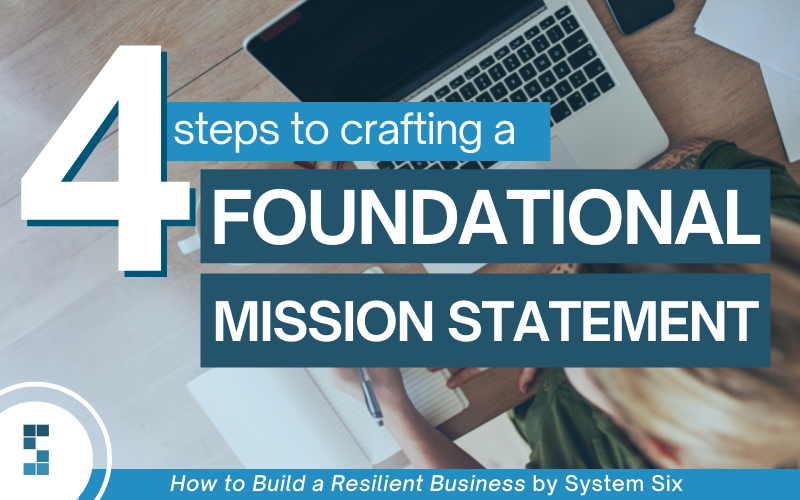This past week, BlackRock CEO Larry Fink released his annual letter to investors. As a leader of one of the largest global investment firms, his words are powerful, poignant, and directive.
He wrote, “It’s never been more essential for CEOs to have a consistent voice, a clear purpose, a coherent strategy, and a long-term view. Your company’s purpose is its north star in this tumultuous environment.”
A resilient business is a successful business. A resilient business is a profitable business. A resilient business adds value and is valued by its stakeholders. A resilient business knows why it exists.
When it comes to business strategies, you have countless books and experts to choose from, covering all manner of topics. There is one strategy, however, that applies to any business, whether you are in the startup stage or are already an established company. That strategy is a well-crafted, written mission statement that clearly articulates your business’ mission, vision, and values.
Don’t be fooled into thinking it sounds too simple to carry so much weight. A well-written mission statement that encompasses who you are and where you are going provides a solid, resilient foundation from which to grow and work. It allows you to weather unexpected, tumultuous years with rooted security and unified vision.
So, what makes a great mission statement? And how do you go about creating one?
Here are 4 steps to crafting a foundational mission statement.
1. Check out the mission statements from companies you admire.
It’s likely that the companies you admire most already have really great mission statements.
Understandably, it can feel overwhelming to take stock of all your business ideas and develop a concise, clear answer to the “why” behind it all. If you feel hesitant or just stuck in this area, it can be constructive to take a close look at the companies you admire and would like to emulate.
Study their mission statements and identify what questions they are answering. Can you distill their mission, vision, and values from their credos? What resonates with your company? What doesn’t? What words and phrases invigorate and inspire you?
A great mission statement will clearly answer the questions of what your mission is, what your vision is, and what your core values are.
If you respect and admire a company, you’ll likely align with its mission, vision, and values as well. Take time to research the statements of these companies for inspiration.
2. Get away with your team.
It’s not uncommon for professional writers to retreat from the distractions and familiarity of their home and office when they need to get an important project finished. Even if writing isn’t part of your profession, we believe that taking that same kind of intentionality when creating your business’ mission statement can be immensely helpful.
Consider taking your team on a “writer’s retreat.” Getting out of the office and into an environment of quiet and rest can provide the right kind of setting to get your team’s collaborative, creative juices flowing.
Ask your team questions like “where are we going?” “What values are most important to us?” “What mission are we trying to accomplish?” Getting away from your day-to-day environment provides the mental breathing room to dig into these more profound questions.
Don’t forget to take thorough notes because these conversations will form the foundation for your mission statement.
3. Rework, refine, and write it down.
There’s a big difference between having your great ideas articulated in your head and actually writing them down.
The process of writing forces you to wrestle with and fine-tune your ideas into their most essential, easily understood forms. Like a sculptor who chisels away at all unnecessary stone until the final sculpture emerges, editing helps you chip away all the excess thoughts and words until you are left with the purest, most clearly defined ideas you want to convey.
This is a process that can’t be rushed. It will take time, intentionality, and, most likely, many re-workings to get just right. It is easy to pile words around a concept; brevity is always the challenge.
This process is not a “one-and-done” practice, however. Plan to regularly visit your statements to ensure you stay true to your mission and values.
4. Infuse your mission statement into your business practices.
Once you’ve got your mission statement written down, it should become your business’ “north star” to follow. Your mission statement should be what you and your team turn to when questions or disruptions inevitably arise. Your mission statement should also attract your customers and future employees.
As an example, one of SSB’s core values has always been the tried and true golden rule: “do unto others as you would have them do unto you.” This value has acted as our north star since our startup season around a kitchen table in Seattle. To this day, it is still a value that we check ourselves by as we work to grow, attract customers, retain employees, and create a rewarding workplace culture.
If we are missing the mark with a core value, we know we are not on track with our company’s mission. Instilling these values in your business will require frequent, habitual integration into your rhythms. Talk about them in leadership gatherings, include them in onboarding procedures and employee onboarding, review them in team meetings. If they only live as an aside on your website, they won’t infiltrate your company’s culture.
As you consider strategies to help grow your business from startup to success in 2022, we can’t encourage you strongly enough to prioritize a well-crafted mission statement. It may sound like a simple strategy, but we guarantee every hour of intention and work you put into clearly defining your mission, vision, and values will pay dividends as you endeavor to build your resilient business.




